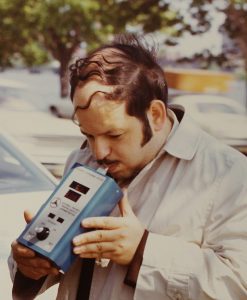A breathalyzer or breathalyser (a portmanteau of breath and analyzer/analyser) is a device for measuring breath alcohol content (BrAC). The name is a genericized trademark of the Breathalyzer brand name of instruments developed by inventor Robert Frank Borkenstein in the 1950s.
Origins
Research into the possibilities of using breath to test for alcohol in a person’s body dates as far back as 1874, when Francis E. Anstie made the observation that small amounts of alcohol were excreted in breath.
In 1927, Emil Bogen produced a paper on breath analysis. He collected air in a football bladder and then tested this air for traces of alcohol, discovering that the alcohol content of 2 litres of expired air was a little greater than that of 1 cc of urine. Also in 1927, a Chicago chemist, William Duncan McNally, invented a breathalyzer in which the breath moving through chemicals in water would change color. One suggested use for his invention was for housewives to test whether their husbands had been drinking.In December 1927, in a case in Marlborough, England, Dr. Gorsky, a police surgeon, asked a suspect to inflate a football bladder with his breath. Since the 2 liters of the man’s breath contained 1.5 mg of ethanol, Gorsky testified before the court that the defendant was “50% drunk”. The use of drunkenness as the standard, as opposed to BAC, perhaps invalidated the analysis, as tolerance to alcohol varies. However, the story illustrates the general principles of breath analysis.
In 1931 the first practical roadside breath-testing device was the drunkometer developed by Rolla Neil Harger of the Indiana University School of Medicine. The drunkometer collected a motorist’s breath sample directly into a balloon inside the machine. The breath sample was then pumped through an acidified potassium permanganate solution. If there was alcohol in the breath sample, the solution changed color. The greater the color change, the more alcohol there was present in the breath. The drunkometer was manufactured and sold by Stephenson Corporation of Red Bank, New Jersey.
In 1954 Robert Frank Borkenstein (1912–2002) was a captain with the Indiana State Police and later a professor at Indiana University Bloomington. His trademarked Breathalyzer used chemical oxidation and photometry to determine alcohol concentrations. The invention of the Breathalyzer provided law enforcement with a quick and portable test to determine an individual’s intoxication level via breath analysis.
Subsequent breath analyzers have converted primarily to infrared spectroscopy. In 1967 in Britain, Bill Ducie and Tom Parry Jones developed and marketed the first electronic breathalyser. They established Lion Laboratories in Cardiff. Ducie was a chartered electrical engineer, and Tom Parry Jones was a lecturer at UWIST.The Road Safety Act 1967 introduced the first legally enforceable maximum blood alcohol level for drivers in the UK, above which it became an offence to be in charge of a motor vehicle; and introduced the roadside breathalyser, made available to police forces across the country. In 1979, Lion Laboratories’ version of the breathalyser, known as the Alcolyser and incorporating crystal-filled tubes that changed colour above a certain level of alcohol in the breath, was approved for police use. Lion Laboratories won the Queen’s Award for Technological Achievement for the product in 1980, and it began to be marketed worldwide. The Alcolyser was superseded by the Lion Intoximeter 3000 in 1983, and later by the Lion Alcolmeter and Lion Intoxilyser.These later models used a fuel cell alcohol sensor rather than crystals, providing a more reliable curbside test and removing the need for blood or urine samples to be taken at a police station. In 1991, Lion Laboratories was sold to the American company MPD, Inc.
Chemistry
When the user exhales into a breath analyzer, any ethanol present in their breath is oxidized to acetic acid at the anode:
C2H5OH(g) + H2O(l) → CH3COOH(l) + 4H+(aq) + 4e−
at the cathode, atmospheric oxygen is reduced:
O2(g) + 4H+(aq) + 4e− → 2H2O(l)
The overall reaction is the oxidation of ethanol to acetic acid and water.
C2H5OH(l) + O2(g) → CH3COOH(aq) + H2O(l)
The electric current produced by this reaction is measured by a microcontroller, and displayed as an approximation of overall blood alcohol content (BAC) by the Alcosensor.


Please contact us for free quotation by form below. We promise the quickest response within 24 hours: